In our daily travels, we may have encountered traffic accidents or driven carefully under complicated road conditions. At this time, traffic signs are like silent guides, guiding us and ensuring road safety. And solar-powered traffic signs, as an important innovation in the field of modern transportation, are playing an increasingly critical role. Have you ever wondered how these signs, which look so ordinary in the sunlight, can still deliver their messages clearly at night or in bad weather? Next, let's delve into the technical principles behind solar-powered traffic signs.
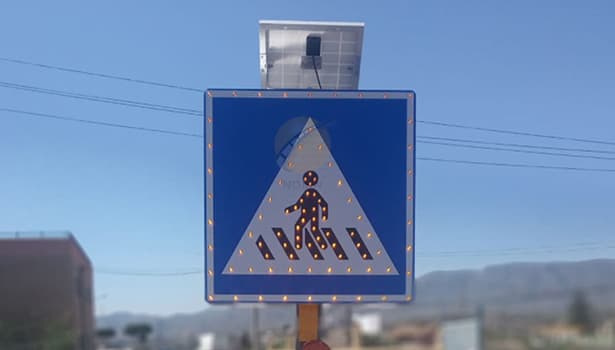
The basic composition of the solar energy traffic signs
1. Component composition
Solar energy traffic signs are mainly composed of poles, with a specific traffic symbol light signboard, and solar panels. The pole is the support structure of the sign, which is firmly set up on the roadside; the lights on the signboard are arranged by the specific traffic symbols, which can display the traffic information at night or under the condition of low visibility; the solar panel is the energy collection device of the whole sign.
2.Material and Role of Solar Traffic Signs
The signboard is usually made of aluminum; the surface is covered with reflective film. The aluminum plate has the characteristics of light quality and corrosion resistance, while the reflective film can reflect the light when the light is irradiated to enhance the visibility of the sign. The uprights are generally made of steel, which is sturdy and durable and can withstand various weather conditions and external forces to ensure the stability of the sign. A solar panel is made of semiconductor material, which can effectively convert solar energy into electricity.
Working principle of solar traffic signs
1.Solar energy conversion link
Solar panels work based on the photoelectric effect principle. When the sun shines on the solar panels, photons, and semiconductor materials interact with electrons so that the electrons get enough energy to get out of the atomic bondage, resulting in electron-hole pairs. These electrons and holes move directionally under the action of an electric field, forming an electric current that realizes the conversion of solar energy into electrical energy. The common types of solar panels available today are monocrystalline, polycrystalline, and amorphous silicon. Monocrystalline silicon solar panels have a high conversion efficiency, usually reaching 20% - 25%; polycrystalline silicon solar panels have a conversion efficiency of about 15% - 20%; and amorphous silicon solar panels have a relatively low conversion efficiency, generally between 10% - 15%.
2.Electrical energy storage and management
After conversion, electrical energy needs to be stored for subsequent use, which requires battery components. In the solar energy traffic signs, the commonly used batteries are lead-acid batteries and lithium batteries. Lead-acid batteries have low cost and mature technology, but their energy density is relatively low, their weight is large, and the number of times they can be charged and discharged is limited, generally around 300-500 times. Lithium batteries, on the other hand, have the advantages of high energy density, lightweight, and a high number of charge/discharge cycles (usually up to 1,000 - 2,000 cycles), but at a relatively high cost.
To ensure the safe and efficient use of the battery, the control circuit plays a crucial role. It can accurately control the charging process of the solar panel on the battery; when the battery is fully charged, it automatically stops charging to prevent damage to the battery from overcharging; when the battery is discharging, it can also monitor the battery voltage in real-time, and when the voltage is too low, it cuts off the discharging circuit to avoid over-discharging. This intelligent charging and discharging control mechanism greatly extends the service life of the battery.
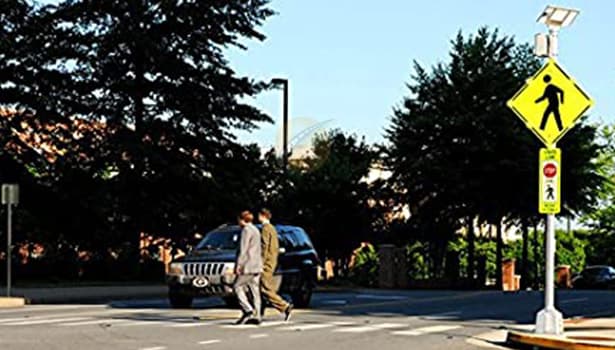
3.Light-emitting and indicating
When the night comes or the light is insufficient, the LED light-emitting element on the signboard starts to work. LED is a light-emitting diode, which has the advantages of high luminous efficiency, long service life, fast response speed, etc. Different colors of LED lights are used in traffic indication. Different colors of LED lights have clear meanings in traffic indication; for example, red means prohibit, stop, yellow means warning, attention, and green means allow, pass. By arranging the LED lights by specific traffic symbols, such as “stop,” “attention to pedestrians,” “sharp turn,” and other patterns, you can convey traffic information to the driver at night.
4.Triggering and control
Solar-powered traffic signs are not always continuous; they can be triggered by motion sensors or buttons. Motion sensors using infrared or microwave technology, when detecting objects (such as pedestrians and vehicles) close to the sign, will automatically trigger the work. For example, at a pedestrian crossing, when a pedestrian approaches, the sensor detects a signal, and the lights on the sign panel begin to flash, alerting drivers to the pedestrian. Pushbuttons are usually installed at locations convenient for pedestrians to operate, and pedestrians can manually press the button to activate the sign as needed.
Wireless communication technology also plays an important role in the signal transmission and control of solar-powered traffic signs. Each sign is equipped with a wireless signal transmitting and receiving device. When a trigger signal is generated, the transmitting device will send out the signal. When the receiving device receives the signal, it will be matched according to the preset address code, and only the sign with the matching address code will be activated, which can avoid false triggering. Moreover, wireless communication technology can also realize a button to control multiple signs, which greatly improves the efficiency and flexibility of traffic instructions.
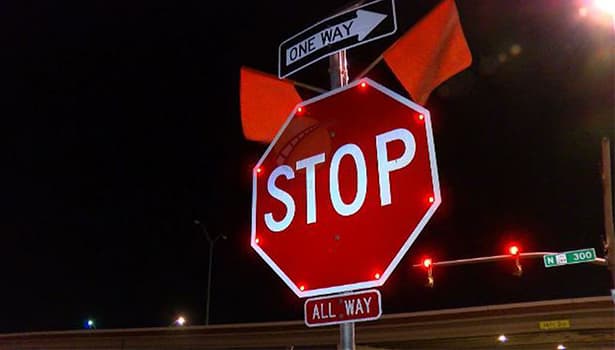
What are the Benefits of Solar-Powered Traffic Signs?
1.High visibility
Solar traffic signs in a variety of environments can effectively improve visibility. Whether in the daytime strong sunlight, in the dark at night on the road, or in the rain and fog and other adverse weather conditions, its unique light-emitting design and reflective materials can ensure that the sign is visible. According to statistics, the installation of solar-powered traffic signs on the road reduced the rate of traffic accidents compared to the non-installed sections of the road by 30% - 40%.
2.Low Maintenance Costs
Because solar traffic signs are independent of the power grid, there is no need to lay complex wires and cables, reducing the maintenance work caused by line failures. Moreover, the solar panels and LED lights used are long-lasting, with the general service life of solar panels reaching 10 - 15 years and that of LED lights reaching 5 - 10 years. Coupled with intelligent control circuits, it can automatically monitor and adjust the system operation so that the solar energy traffic sign's maintenance costs are extremely low and almost maintenance-free.
3.Adapt to all kinds of weather
LED lights have good weather resistance, in high temperatures, low temperatures, humidity, sand and dust, and other adverse weather conditions, and can still maintain stable performance and visibility. In rainstorms, the brightness of the LED lights will not be significantly affected and can continue to provide drivers with clear traffic instructions; in the cold winter, there will be no start-up difficulties due to low temperatures or unstable light-emitting situations.
4.Energy self-sufficiency
solar traffic signs rely entirely on solar power supply, without access to utility power, the real realization of energy self-sufficiency. This not only saves a lot of electricity expenses but also reduces the dependence on traditional energy sources and reduces carbon emissions, in line with the current global advocacy of energy conservation and environmental protection concepts. It is estimated that a solar-powered traffic sign can reduce carbon emissions by about 500 kg per year.
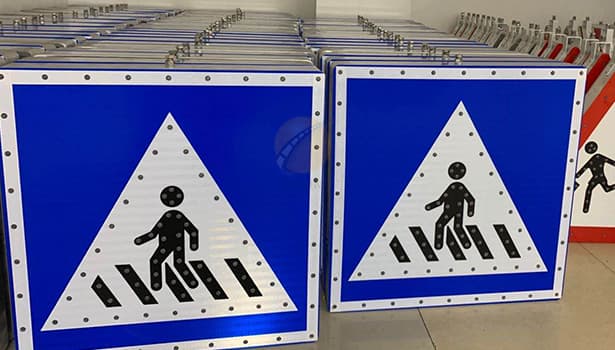
The Widespread Use of Solar Traffic Signs
1.Urban traffic
On urban roads, solar traffic signs can be seen everywhere. At intersections, it can indicate the direction of vehicles, turning rules, etc.; in the school area, it can remind drivers to slow down and pay attention to the safety of students; in construction zones, it can timely inform drivers of the road conditions ahead, such as road closure, construction detours, and other information, which can effectively guarantee the smoothness and safety of urban traffic.
2.Rural roads
In rural areas, due to low population density, infrastructure is relatively weak, and the traditional traffic signs are often difficult to see at night. The emergence of solar-powered traffic signs solves this problem; they can automatically light up at night so that drivers can see the sign information from a distance, greatly reducing the risk of traffic accidents on rural roads. In some narrow country lanes, solar-powered traffic signs can remind drivers to pay attention to the meeting, avoid pedestrians, and so on.
3.Remote areas
in the power scarcity or no power supply in remote areas, solar traffic signs of independent power supply advantages have been fully realized. In the mountains, deserts, and other remote areas, laying the power grid is costly and difficult, and solar traffic signs can be easily installed and work normally. In the mountainous areas of the mountain highway, solar traffic signs can provide drivers with curves, steep slopes, and other dangerous sections of the warning information.
4.Emergency scenarios
in natural disasters lead to power outages, the role of solar traffic signs is particularly important. After earthquakes, floods, and other disasters, the city's power system may be seriously damaged. At this time, the solar traffic signs can continue to work for the affected people and rescue workers to provide evacuation routes and safe areas of information to ensure the smooth progress of the emergency rescue work. In the city after the earthquake, solar traffic signs can indicate safe places of refuge and rescue channels.
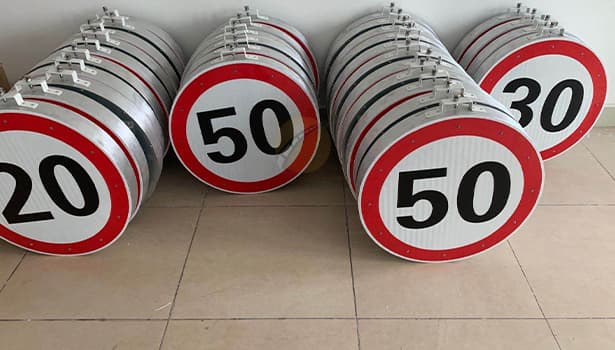
Current situation of the industry and prospects
1.The current situation of the industry
At present, solar traffic signs are widely used worldwide. In Europe, the United States, and other developed countries, solar-powered traffic signs have become an important part of transportation facilities, widely used in urban roads, highways, rural roads, and other areas. In developing countries, with the increasing awareness of traffic safety and environmental protection, the application of solar traffic signs is also gradually increasing. In China, solar-powered traffic signs have been installed on many urban roads and newly built highways, and some rural areas have also begun to promote their use.
2.Future Prospects
The continuous development of intelligent transportation and environmental protection concepts and solar-powered traffic signs will also usher in more technological innovation and application expansion. In the future, solar traffic signs may be deeply integrated with the Internet of Things technology to achieve real-time collection and transmission of traffic information. The sign can automatically adjust the display content and brightness according to real-time traffic flow, weather conditions, and other factors to improve the intelligent level of traffic management. Moreover, with the continuous progress of solar energy technology, the conversion efficiency of solar panels will be further improved and the cost will be reduced, making solar traffic signs more popular and economically practical.

Conclusion
Solar traffic signs play an indispensable role in modern transportation because of their unique working principle, significant advantages, and wide range of application scenarios. It not only improves the level of road traffic safety but also contributes to energy saving and environmental protection. We should pay more attention to and adopt solar-powered traffic signs to further promote the intelligent and green development of the transportation field. Let us all look forward to solar traffic signs in the future to continue to innovate and create a safer, more convenient, and environmentally friendly travel environment for us.

 English
English  Arabic
Arabic  Bulgarian
Bulgarian  Chinese (Simplified)
Chinese (Simplified)  Chinese (Traditional)
Chinese (Traditional)  Croatian
Croatian  Czech
Czech  Danish
Danish  Dutch
Dutch  Finnish
Finnish  French
French  German
German  Greek
Greek  Hindi
Hindi  Italian
Italian  Japanese
Japanese  Korean
Korean  Norwegian
Norwegian  Polish
Polish  Portuguese
Portuguese  Romanian
Romanian  Russian
Russian  Spanish
Spanish  Swedish
Swedish  Catalan
Catalan  Filipino
Filipino  Hebrew
Hebrew  Indonesian
Indonesian  Latvian
Latvian  Lithuanian
Lithuanian  Serbian
Serbian  Slovak
Slovak  Slovenian
Slovenian  Ukrainian
Ukrainian  Vietnamese
Vietnamese  Albanian
Albanian  Estonian
Estonian  Galician
Galician  Hungarian
Hungarian  Maltese
Maltese  Thai
Thai  Turkish
Turkish  Persian
Persian  Afrikaans
Afrikaans  Malay
Malay  Swahili
Swahili  Irish
Irish  Welsh
Welsh  Belarusian
Belarusian  Icelandic
Icelandic  Macedonian
Macedonian  Yiddish
Yiddish  Armenian
Armenian  Azerbaijani
Azerbaijani  Basque
Basque  Georgian
Georgian  Haitian Creole
Haitian Creole  Urdu
Urdu  Bengali
Bengali  Bosnian
Bosnian  Cebuano
Cebuano  Esperanto
Esperanto  Gujarati
Gujarati  Hausa
Hausa  Hmong
Hmong  Igbo
Igbo  Javanese
Javanese  Kannada
Kannada  Khmer
Khmer  Lao
Lao  Latin
Latin  Maori
Maori  Marathi
Marathi  Mongolian
Mongolian  Nepali
Nepali  Punjabi
Punjabi  Somali
Somali  Tamil
Tamil  Telugu
Telugu  Yoruba
Yoruba  Zulu
Zulu  Myanmar (Burmese)
Myanmar (Burmese)  Chichewa
Chichewa  Kazakh
Kazakh  Malagasy
Malagasy  Malayalam
Malayalam  Sinhala
Sinhala  Sesotho
Sesotho  Sudanese
Sudanese  Tajik
Tajik  Uzbek
Uzbek  Amharic
Amharic  Corsican
Corsican  Hawaiian
Hawaiian  Kurdish (Kurmanji)
Kurdish (Kurmanji)  Kyrgyz
Kyrgyz  Luxembourgish
Luxembourgish  Pashto
Pashto  Samoan
Samoan  Scottish Gaelic
Scottish Gaelic  Shona
Shona  Sindhi
Sindhi  Frisian
Frisian  Xhosa
Xhosa 




